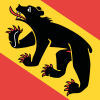Canton of Bern
| |
|---|---|
|
| |
 | |
| Coordinates: 46°50′N 7°36′E / 46.84°N 7.60°E | |
| Country | Switzerland |
| Capital | Bern |
| Subdivisions | 388 municipalities, 10 districts |
| Government | |
| • President | Evi Allemann |
| • Executive | Regierungsrat, Conseil exécutif (7) |
| • Legislative | Grosser Rat, Grand conseil (160) |
| Area | |
• Total | 5,959.59 km2 (2,301.01 sq mi) |
| Population (December 2020)[2] | |
• Total | 1,043,132 |
| • Density | 180/km2 (450/sq mi) |
| GDP | |
| • Total | CHF 80.209 billion (2020) |
| • Per capita | CHF 77,027 (2020) |
| ISO 3166 code | CH-BE |
| Highest point | 4,274 m (14,022 ft): Finsteraarhorn |
| Lowest point | 401.5 m (1,317 ft): Aare at Wynau |
| Joined | 1353 |
| Languages | German, French |
| Website | www |
The canton of Bern, or Berne (German: Kanton Bern; French: canton de Berne; Romansh: Chantun Berna; Italian: Canton Berna), is one of the 26 cantons forming the Swiss Confederation. Its capital city, Bern, is also the de facto capital of Switzerland. The bear is the heraldic symbol of the canton, displayed on a red-yellow background.
Comprising ten districts, Bern is the second-largest canton by both surface area and population. Located in west-central Switzerland, it is surrounded by eleven cantons. It borders the cantons of Jura and Solothurn to the north. To the west lie the cantons of Neuchâtel, Fribourg, and Vaud. To the south lies the cantons of Valais. East of the canton of Bern lie the cantons of Uri, Nidwalden, Obwalden, Lucerne and Aargau. The geography of the canton includes a large share of all three natural regions of Switzerland: the Jura Mountains (the Bernese Jura), the Swiss Plateau (the Bernese Mittelland) and the Alps (the Bernese Oberland).
The canton of Bern is bilingual, officially German- and French-speaking, and has a population (as of 31 December 2020) of 1,043,132.[2] The largest city, Bern, is also the seat of the federal government of Switzerland. Other major cities are Thun and Biel/Bienne. The canton is also renowned for its numerous Alpine resort towns, notably Interlaken and Gstaad.
Formerly part of the Holy Roman Empire, the canton of Bern entered an alliance with the Swiss Forest Cantons in 1323 and joined the Old Swiss Confederacy in 1353.
- ^ Arealstatistik Land Cover - Kantone und Grossregionen nach 6 Hauptbereichen accessed 27 October 2017
- ^ a b "Ständige und nichtständige Wohnbevölkerung nach institutionellen Gliederungen, Geburtsort und Staatsangehörigkeit". bfs.admin.ch (in German). Swiss Federal Statistical Office - STAT-TAB. 31 December 2020. Retrieved 21 September 2021.
- ^ Statistik, Bundesamt für (21 January 2021). "Bruttoinlandsprodukt (BIP) nach Grossregion und Kanton - 2008-2018 | Tabelle". Bundesamt für Statistik (in German). Retrieved 1 July 2023.



